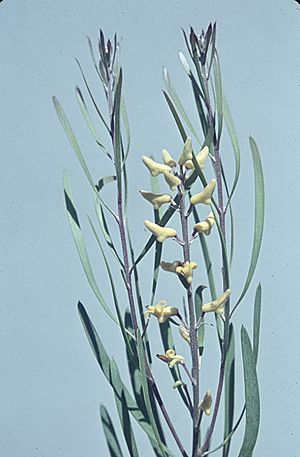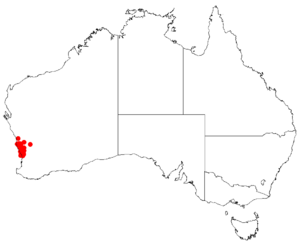Persoonia comata facts for kids
Quick facts for kids Persoonia comata |
|
|---|---|
 |
|
| Scientific classification | |
| Genus: |
Persoonia
|
| Species: |
comata
|
 |
|
| Occurrence data downloaded from AVH | |
| Synonyms | |
|
Linkia comata (Meisn.) Kuntze |
|
The Persoonia comata is a type of flowering plant that belongs to the Proteaceae family. It is found only in the south-west part of Western Australia. This plant is a shrub that can grow upright or sometimes spread out low to the ground. It usually has smooth bark and leaves shaped like a spatula or a spear. Its bright yellow flowers often grow in groups of ten to fifty along a stem up to 250 millimeters (about 10 inches) long.
Contents
What Does Persoonia comata Look Like?
Persoonia comata is a shrub that typically grows from 0.2 to 1.5 meters (about 8 inches to 5 feet) tall. It has smooth grey bark, which might be a bit flaky near the bottom. When the young branches first grow, they are quite hairy. However, as they get older, they become smooth.
Leaves and Flowers
The leaves of this plant grow one after another along the stems. They are narrow and can be shaped like a spatula or a spear, with the narrower end closer to the stem. These leaves are usually between 55 and 150 millimeters (about 2 to 6 inches) long and 2.5 to 17.5 millimeters (about 0.1 to 0.7 inches) wide.
The flowers usually grow in groups of ten to fifty along a main stem called a rachis. This rachis can be anywhere from 20 to 250 millimeters (about 0.8 to 10 inches) long. Each flower sits on its own small stalk, called a pedicel, which is 5 to 25 millimeters (about 0.2 to 1 inch) long.
The flower parts, called tepals, are bright yellow and sometimes have a pink tint. They are hairy on the outside. The top tepal is 9 to 15 millimeters (about 0.35 to 0.6 inches) long. The side tepals are not perfectly even, and the bottom tepal is shaped like a small sac. The parts of the flower that hold pollen, called anthers, are bright yellow with white tips.
When It Flowers and Fruits
Persoonia comata flowers during the warmer months, from November to February. After flowering, it produces a fruit that is shaped like an oval. This fruit is a type of drupe, which means it has a fleshy outer part and a hard pit inside, like a peach. The fruit is usually 8.5 to 11.5 millimeters (about 0.3 to 0.45 inches) long and 5 to 7 millimeters (about 0.2 to 0.27 inches) wide.
How Persoonia comata Got Its Name
The plant Persoonia comata was first officially described in 1855. This description was made by a botanist named Carl Meissner. He published his findings in a scientific journal called Journal of Botany and Kew Garden Miscellany, which was edited by William Jackson Hooker.
Where Persoonia comata Grows
This type of geebung plant can be found in forests and woodlands where Eucalyptus and Banksia trees grow. It also grows in areas with heath, which is a type of shrubland. You can find it in coastal areas between Jurien Bay (near Mount Peron) and Yanchep. These areas are part of the Avon Wheatbelt, Geraldton Sandplains, and Swan Coastal Plain regions in Western Australia.
Is Persoonia comata Endangered?
The good news is that Persoonia comata is not considered to be in danger. The Western Australian Government's Department of Parks and Wildlife has classified it as "not threatened." This means there are enough of these plants in the wild, and they are not currently at risk of disappearing.

